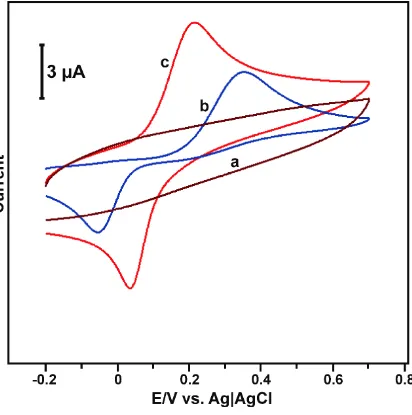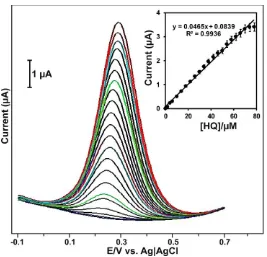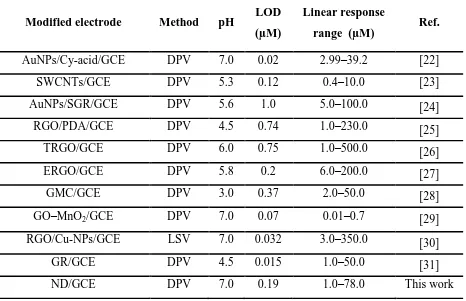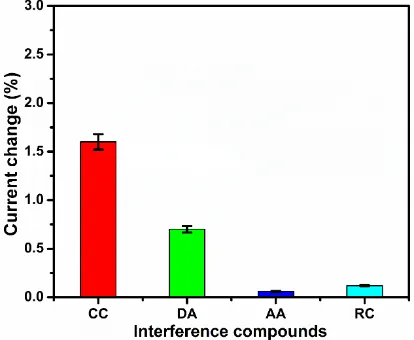Int. J. Electrochem. Sci., 12 (2017) 8021 – 8032, doi: 10.20964/2017.09.05
International Journal of
ELECTROCHEMICAL
SCIENCE
www.electrochemsci.org
Sensitive and Low-potential Electrochemical Detection of
Hydroquinone Using a Nanodiamond Modified Glassy Carbon
Electrode
Tse-Wei Chen1, Selvakumar Palanisamy1, 2, Shen-Ming Chen1*, Vijayalakshmi Velusamy2 , Yung-Hsien Liu3, Tien-Wen Tseng1, Ming-Chin Yu4, Shih-Yi Lee5, Wen-Han Chang6,7,8, Xiaoheng Liu9,*
1
Department of Chemical Engineering and Biotechnology, National Taipei University of Technology, Taipei 106, Taiwan (ROC)
2
Division of Electrical and Electronic Engineering, School of Engineering, Manchester Metropolitan University, Manchester – M1 5GD, United Kingdom.
3
National Chung-Shan Institute of Science & Technology, Taiwan (ROC).
4
Department of Surgery, Chang Gung Memorial Hospital Linkou Branch, Chang Gung University, Taoyuan, Taiwan. (Department of Surgery, Chang Gung Memorial Hospital at Linkou,) No. 5, Fu-Hsing Street, Kweishan, Taoyuan, 333, Taiwan (ROC).
5
Division of Pulmonary and Critical Care Medicine, Mackay Memorial Hospital; Mackay Junior College of Medicine, Nursing, and Management, Taiwan (ROC).
6
Department of Emergency Medicine, Mackay Memorial Hospital; Institute of Mechatronic Engineering, National Taipei University of Technology, Taiwan (ROC).
7
MacKay Memorial College Department of Cardiology, MacKay Memorial Hospital, Taiwan (ROC).
8
Graduate Institute of Injury Prevention and Control, Taipei Medical University; School of Medicine, Taipei Medical University, Taiwan (ROC).
9
Key Laboratory of Education Ministry for Soft Chemistry and Functional Materials, Nanjing University of Science and Technology, Nanjing 210094, China.
*
E-mail: smchen78@ms15.hinet.net; ; xhliu@mail.njust.edu.cn
Received: 31 May 2017 / Accepted: 1 July 2017 / Published: 13 August 2017
µM. The sensor shows an appropriate selectivity in the presence of 20-fold concentrations of benzenediols and neurotransmitters. The practicality of the sensor is appropriate and shows excellent recovery of HQ in lab water samples.
Keywords: Nanodiamond; Modified electrode; Cyclic voltammetry; Hydroquinone, Electroanalysis
1. INTRODUCTION
The fabrication of nanomaterial-based modifiers has received considerable attention in electroanalytical chemistry due to their great potential capacity and signal-enhancing characteristics [1]. Accordingly, the fabrication of stable and reproducible electrode matrix with tunable electrochemical and electrocatalytic properties is of interest in electrochemical sensors [1]. Consequently, range of nanomaterials have been used as a modifier for electrochemical sensing of different molecules [2–4]. Nanodiamond (ND) has been recognised to have excellent lubricity, high electrical resistivity and thermal conductivity along with high chemical stability and biocompatibility for over two decades [5]. In view of these unique properties, ND has been widely used in different fields of science and technology [6]. In recent years, ND modified electrodes have been used for electrochemical sensing of pharmaceutical compounds [7, 8].
Hydroquinone (HQ) is widely acknowledged for its toxic nature in biological systems and the ecological environment stemming from its routine use in the applications such as pesticides, medicines, cosmetics, and dyes [9–11]. Consequently, a variety of analytical techniques has been employed for the detection of HQ, which include chromatography, chemiluminescence, spectrophotometry, and electrochemical methods [12]. Electrochemical methods have significant advantages over other methods in terms of low cost and simple operation [12]. However, the poor selectivity and sensitivity of conventional electrodes represents an obstacle to the detection of HQ [13]. Consequently, modified electrodes materials applied for the sensitive and selective detection of HQ to date include carbon materials, metal alloy nanoparticles, electroactive dyes, and metal oxides [14–17]. Herein, we report the fabrication of ND modified electrode for the sensitive and selective detection of HQ. The unique properties of ND modified electrode translate to enhanced electrocatalytic activity, and lower overpotential towards the detection of HQ. The effect of scan rate and pH on the redox electrochemical behavior of HQ at ND modified electrode was studied and discussed. As a proof of concept, the ND modified electrode was used for the detection of HQ concentration in laboratory water samples. The selectivity of the sensor also studied and discussed in the manuscript.
2. EXPERIMENTAL
2.1 Materials and method
Sigma Aldrich, Taiwan. The supporting electrolyte, pH 7.0 phosphate buffer was prepared using 0.1 M Na2HPO4 and NaH2PO4 solutions. All stock solutions were prepared using the double distilled water.
Cyclic voltammetric studies were performed using a CHI 1205b electrochemical workstation from CH instruments. Differential pulse voltammetry (DPV) experiments were performed using a CHI410A electrochemical workstation. Hitachi S-3000 High-resolution scanning electron microscopic (SEM) image of ND was taken using Hitachi S-4300SE/N High Resolution Schottky Analytical VP scanning electron microscope. Elemental distribution of ND was analyzed using Hitachi S-4300SE/N High Resolution Schottky Analytical VP scanning electron microscope attached BRUKER AXS elemental analyzer. Fourier transform infrared (FTIR) spectrum of ND was conducted using a JASCO FTIR-6600 spectrometer. Raman spectra of ND was acquired using a Dong Woo 500i Raman spectrometer equipped with a charge-coupled detector. A ND modified glassy carbon electrode (GCE) was used as a working electrode and a saturated Ag/AgCl and a platinum wire were used as reference and counter electrodes respectively. The electrochemical measurements were carried out in deoxygenated pH 7.0 at a room temperature.
2.2. Fabrication of ND modified electrode
In order to prepare ND modified electrode, the GCE was first cleaned using alumina polishing kit, and dried in an air oven. The ND solution was prepared by adding ND (2 mg/mL) to double distilled water and sonicated for 20 min. Approximately 8 µL of ND solution was then dropped on the surface of pre-cleaned GCE and the modified electrode dried in an air oven. The ND modified GCE was further used for electrochemical studies. The geometric and active surface area of unmodified and ND modified GCEs were 0.79 and 0.92 cm2, respectively.
3. RESULTS AND DISCUSSION
3.1. Characterizations of ND
The surface morphology of ND was investigated using high-resolution scanning electron microscopy and the SEM image of ND is shown in Fig. 1A.
The SEM image of ND clearly reveals the high quality nanocrystalline nature of ND, which is in good agreement with the published literature. The elemental distribution of ND (Fig. 1B) confirms the presence of carbon and oxygen in ND. The results also reveal the presence of oxygen functional groups in ND. The presence of functional groups in ND was confirm by FTIR, since FTIR has been widely used as an effective probe for characterizing of functional materials. Fig. 1C shows FTIR spectra of ND and clearly shows the presence of carbonyl and –OH groups, with their corresponding stretching vibrations appearing at 1826 and 3424 cm-1 [18]. In addition, ND also shows three district peaks at 1677, 1469 and 1193 cm-1, attributable to the –OH of water, –CH2 scissor deformation and
shown in Fig. 1D. A sharp peak was observed at 1308 cm−1, due to the T2G mode of ND [20]. In
addition, the organics stretching vibrations for ND appear at 1415 cm-1. However, the E2g mode is
lower than T2G mode in ND and reveals the presence of an increased number of effects in ND [20].
Figure 1. A) SEM image of ND and B) the elemental distribution image of carbon and oxygen in ND. C) FTIR and Raman (D) spectra of ND.
3.2. Electrochemical behavior of ND modified electrode towards HQ
[image:4.596.74.523.154.510.2]
Figure 2. Cyclic voltammetry response obtained at bare (b) and ND (c) modified electrodes in 150 µM HQ containing pH 7.0 at a scan rate of 50 mV/s. At similar conditions, the cyclic voltammetry response of ND modified electrode in the absence of HQ in pH 7.0.
The oxidation and reduction potentials of HQ for the ND modified electrode appeared at 0.255 and 0.012 V with a peak-to-peak separation (∆Ep) of 243 mV. The oxidation and reduction peaks are
due to the redox behavior of oxidized quinone on the electrode surface [21]. In contrast, the unmodified GCE shows oxidation potentials of HQ at 0.352 and –0.055 V with an ∆Ep of
[image:6.596.154.444.67.371.2]
Figure 3. Cyclic voltammograms for ND modified electrode in 150 µM HQ containing pH 7.0 at different scan rates; the scan rates in the ranging from 20 to 200 mV/s. Inset is the linear dependence of square root of scan rate vs. anodic and cathodic peak current of HQ.
[image:6.596.148.448.441.722.2]
The effect of scan rate on electrochemical redox behavior of HQ at ND modified electrode was investigated by CV. Fig. 3 displays the cyclic voltammetry response of ND modified electrode in pH 7.0 containing 150 µM HQ across scan rates from 20–200 mV/s. It can be seen that the anodic and cathodic peak current of HQ increases with increasing scan rates from 20 to 200 mV/s. In addition, the linear plot of square root of scan rates vs. anodic and cathodic peak current clearly suggests that the anodic and cathodic peak currents of HQ has a linear relationship with square root of scan rates from 20 to 200 mV/s (inset). The linear regression equation for anodic and cathodic peak current vs. square root of scan rate is Epa= –1.5308 (ν1/2) –1.1306 (R2 = 0.9993) and Epc= 1.6165 (ν1/2) –1.3241 (R2 =
0.9981). The result indicates that the electrochemical redox behavior of HQ at ND modified electrode is diffusion controlled electrochemical process [11]. The pH of the electrolyte solution can affect the redox behavior of HQ at ND modified electrode, since the redox behavior of HQ is pH dependent.
Fig. 4 shows the effect of pH on the redox behavior of 250 µM HQ at ND modified electrode. The pH was tested in the range of 3 to 9. The ND modified electrode exhibited a good redox behavior for different pH containing HQ and indicates the involving of protons in the electrochemical redox reaction of HQ. In addition, the formal potential (E0’) of HQ (defined as (Epa + Epc)/2) demonstrates a
linear relationship with pH between pH3 and pH9 (inset). The linear regression equation for E0’ vs. pH is Ep = -0.0554 mV/pH + 0.5176 (0.9986). The obtained slope value of 55.4 mV/pH is clear indicates
that the redox electrochemical reaction of HQ is involving of an equal number of protons and electrons, and similar slope value has been reported earlier in the literatures [15].
3.3. Determination of HQ
[image:7.596.165.432.444.701.2]
The ND modified electrode was further used for the determination of HQ by DPV. Fig. 5 shows DPV response of ND modified electrode in the absence and presence of different concentrations (1.0-84.0 µM) of HQ containing pH 7.0. The ND modified electrode does not show any DPV response in the absence of HQ (bottom curve), while a clear response was observed for the presence of 1.0, 3.0 and 5.0 µM HQ.
Table 1. Analytical comparison of ND modified electrode with previously reported modified electrodes for determination of HQ.
Modified electrode Method pH LOD (µM)
Linear response
range (µM) Ref.
AuNPs/Cy-acid/GCE DPV 7.0 0.02 2.99–39.2 [22]
SWCNTs/GCE DPV 5.3 0.12 0.4–10.0 [23]
AuNPs/SGR/GCE DPV 5.6 1.0 5.0–100.0 [24]
RGO/PDA/GCE DPV 4.5 0.74 1.0–230.0 [25]
TRGO/GCE DPV 6.0 0.75 1.0–500.0 [26]
ERGO/GCE DPV 5.8 0.2 6.0–200.0 [27]
GMC/GCE DPV 3.0 0.37 2.0–50.0 [28]
GO–MnO2/GCE DPV 7.0 0.07 0.01–0.7 [29]
RGO/Cu-NPs/GCE LSV 7.0 0.032 3.0–350.0 [30]
GR/GCE DPV 4.5 0.015 1.0–50.0 [31]
ND/GCE DPV 7.0 0.19 1.0–78.0 This work
Abbreviations
LOD – Limit of detection; AuNPs – gold nanoparticles; Cy-acid – cysteic acid; GCE – glassy carbon electrode; DPV – differential pulse voltammetry; SWCNT – single walled carbon nanotubes; SGR – sulfonated graphene; RGO – reduced graphene oxide; polydopamine; TRGO – thermally reduced graphene oxide; ERGO – electrodeposition of reduced graphene oxide; GMC - graphitic mesoporous carbon; GO – graphene oxide; MnO2 – Manganese dioxide; Cu NPs – copper nanoparticles; LSV –
linear sweep voltammetry; GR- graphene
[image:8.596.68.534.226.527.2]
reported modified electrodes [22–31]. Hence, the fabricated MD modified electrode can be used as an alternative for accurate detection of HQ.
[image:9.596.90.504.277.617.2]The selectivity of the sensor was investigated in presence of benzenediols (catechol and resorcinol) and neurotransmitters (dopamine) by DPV, since these compounds have similar structural and chemical activity on modified electrodes [32, 33]. Fig. 6 shows the effect of 20-fold concentration addition of interfering compounds on the differential pulse voltammetric current response change of 3.0 µM HQ at ND modified electrode at pH 7.0. Fig. 6 clearly reveals that the effect of ascorbic acid and resorcinol caused less effect on the HQ response current of the ND modified electrode, while dopamine and catechol showed an increased effect on HQ response. However, the effect caused by the interference was less than 4% on ND modified electrode and supports the selective nature of the sensor.
Figure 6. The effect of interfering compounds (20-fold additions) on the DPV current response change of 3 µM HQ at ND modified electrode in pH 7.0.
samples and the results were tabulated in Table. 2. The Table 2 confirms that the ND modified electrode has appropriate recovery towards HQ in lab water samples and the average recoveries were 97.6% with the relative standard deviation (RSD, 3 measurements) of 3.2%. The result clearly implies that the ND modified electrode is applicable to the precise detection of HQ in water samples.
Table 2. Determination of HQ in lab water samples using ND modified electrode by DPV. RSD is relative to 3 measurements.
Sample Detected (µM)
Added (µM)
Found (µM)
Recovery
(%) RSD (%)
Lab water Not detected
3.0 2.91 97.0 2.9
5.0 4.87 96.8 3.7
8.0 7.93 99.1 3.1
4. CONCLUSIONS
In conclusion, we have reported a sensitive electrochemical sensor for determination of HQ using GCE modified with ND. The ND modified electrode not only enhanced the current response but also showed lower oxidation potential when compared with unmodified GCE. The effect of scan rate studies confirmed that electrochemical redox behavior of HQ was a purely diffusion controlled process on ND modified electrode. The ND modified electrode showed appropriate analytical performance towards detection of HQ and was comparable with previously reported HQ sensors. The sensor exhibited a high selectivity and good practicality for detection of HQ. However, the detection of HQ in presence of high concentrations of CC (>100 µM) would be a problematic using ND modified electrode due to the cross reactivity of CC with HQ.
ACKNOWLEDGEMENTS
The project was supported by the Ministry of Science and Technology (MOST), Taiwan. This work also jointly supported by the projects from NTUT-CGMH-106-4 (CGMH-NTUT Joint Research Program, CORPG1G0021), NTUT-MMH-106-06, NTUT-NUST-106-1 and 206I19, National Taipei University of Technology and cooperation institute, hospitals, and Universities.
References
1. C. Zhu, G. Yang, H. Li, D. Du and Y. Lin, Anal. Chem. 87 (2015) 230.
2. X. Zhang, S. Duan, X. Xu, S. Xu and C. Zhou, Electrochim. Acta 56 (2011) 1981.
[image:10.596.67.529.207.328.2]
4. Y.H. Huang, J.H. Chen, X. Sun, Z.B. Su, H.T. Xing, S.R. Hu, W. Weng, H.X. Guo, W.B. Wu and Y.S. He, Sensors Actuators B Chem. 212 (2015) 165.
5. G. J. Germann, G. M. Mcclelland, Y. Mitsuda, M. Buck and H. Seki, Rev. Sci. Instrum., 63 (1992) 4053.
6. M.E. Drew, A.R. Konicek, P. Jaroenapibal, R.W. Carpick and Y. Yamakoshi, J. Mater. Chem. 22 (2012) 12682.
7. S. Shahrokhian and M. Ghalkhani, Electrochim. Acta 55 (2010) 3621.
8. A.F. Azevedo, M.R. Baldan and N.G. Ferreira, Int. J. Electrochem. 2012 (2012) 16.
9. X. Niu, L. Yan, X. Li, Z. Wen, J. Yu, A. Hu, L. Dong, Z. Shi and W. Sun, Int. J. Electrochem. Sci., 11 (2016) 7139.
10.H.N.A. Mustafa, I.M. Isa, N.M. Ali, N. Hashim, M. Musa and S.A. Ghani, Int. J. Electrochem. Sci., 10 (2015) 9232.
11.R. Madhu, S. Palanisamy, S.M. Chen and S. Piraman, J. Electroanal. Chem. 727 (2014) 84.
12.W. Zhang, J. Zheng, Z. Lin, L. Zhong, J. Shi, C. Wei, H. Zhang, A. Hao and S. Hu, Anal. Methods 7 (2015) 6089.
13.X. Ma, Z. Liu, C. Qiu, T. Chen and H. Ma, Microchim. Acta 180 (2013) 461.
14.R. Chen, Q. Wang, Y. Li, Y. Gu, L. Tang, C. Li and Z. Zhang, RSC Adv. 5 (2015) 44165.
15.A.T.E. Vilian, S.M. Chen, L.H. Huang, M.A. Ali and F.M.A. Al-Hemaid, Electrochim. Acta 125 (2014) 503.
16.X. Yuan, D. Yuan, F. Zeng, W. Zou, F. Tzorbatzoglou, P. Tsiakaras and Y. Wang, Appl. Catal., B, 129 (2013) 367.
17.W. Sun, Y. Wang, Y. Lu, A. Hu, F. Shi and Z. Sun, Sens. Actuators, B, 188 (2013) 564.
18.N.O. Mchedlov-Petrossyan, N.N. Kamneva, A.I. Marynin, A.P. Kryshtal and E. Ōsawa, Phys. Chem. Chem. Phys., 17 (2015) 16186.
19.G. Dordelmann, T. Meinhardt, T. Sowik, A. Krueger and U. Schatzschneider, Chem. Commun., 48 (2012) 11528.
20.P.W. May, J.A. Smith and Y.A. Mankelevich, Diamond Relat. Mater. 15 (2006) 345. 21.S.M. Wang, W.Y. Su, S.H. Cheng, Int. J. Electrochem. Sci., 5 (2010) 1649.
22.G. Karim-Nezhad, M.H. Moghaddam, Z. Khorablou and P.S. Dorraji, J. Electrochem. Soc. 164 (2017) B193.
23.Z. Wang, S. Li and Q. Lv, Sensors and Actuators B 127 (2007) 420.
24.L. Wang, Y. Meng, Q. Chen, J. Deng, Y. Zhang, H. Li and S. Yao, Electrochim. Acta, 92 (2013) 216.
25.L. Zheng, L. Xiong, Y. Li, J. Xu, X. Kang, Z. Zou, S. Yang and J. Xia, Sens. Actuators B, 177 (2013) 344.
26.S.J. Li, C. Qian, K. Wang, B.Y. Hua, F.B. Wang, Z.H. Sheng and X.H. Xia, Sens. Actuators B, 174 (2012) 441.
27.L. Chen, Y. Tang, K. Wang, C. Liu and S. Luo, Electrochem. Commun. 13 (2011) 133.
28.X. Yuan, D. Yuan, F. Zeng, W. Zou, F. Tzorbatzoglou, P. Tsiakaras and Y. Wang, Appl. Catal. B, 129 (2013) 367.
29.T. Gan, J. Sun, K. Huang, L. Song and Y. Li, Sens. Actuators B, 177 (2013) 412.
30.S. Palanisamy, C. Karuppiah, S.M. Chen, C.Y. Yang and P. Periakaruppan, Anal. Methods, 6 (2014) 4271.
31.H. Du, J. Ye, J. Zhang, X. Huang and C. Yu, J. Electroanal. Chem., 650 (2011) 209.
32.T.W. Chen, S. Palanisamy, S.M. Chen, V. Velusamy, H. Ramasubbu and S.K. Ramaraj, Adv. Mater. Lett. 8 (2017) 852.
33.T.W. Chen, S. Palanisamy, S.M. Chen, V. Velusamy and S.K. Ramaraj, Int. J. Electrochem. Sci., 12 (2017) 4107.
35.V. Velusamy, S. Palanisamy, S.M. Chen, T.W. Chen, S. Selvam, S.K. Ramaraj and B.S. Lou, Sens. Actuators, B 252 (2017) 175.
36. S. Palanisamy, T. Kokulnathan, S.M. Chen, V. Velusamy and S.K. Ramaraj, J. Electroanal. Chem. 794 (2017) 64.
37.S. Palanisamy, S.K. Ramaraj, S.M. Chen, T.W. Chiu, V. Velusamy, T.C.K. Yang, T.W. Chen and S. Selvam, J. Colloid Interface Sci. 496 (2017) 364.






